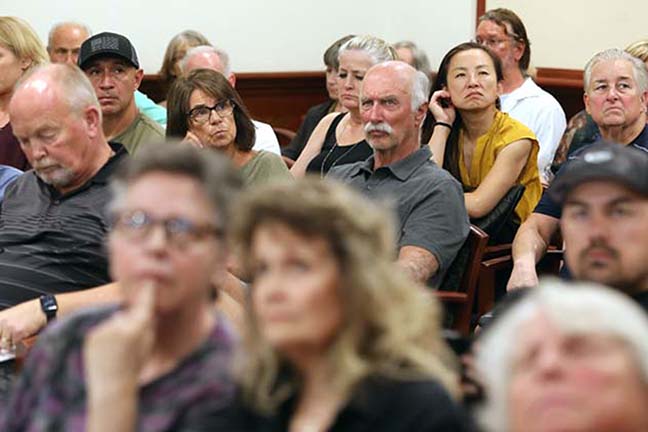Housing again tops list of year’s biggest city news stories

Stakeholders at the July 12 Claremont City Council meeting listen in as the body considers an update to its housing element. Courier photo/Steven Felschundneff
by Steven Felschundneff | steven@claremont-courier.com
For the second consecutive year housing tops the list of the Courier’s biggest news stories, with a focus on making it more affordable.
The city finally approved its long overdue update to the housing element, a document that clearly illustrates how the city will fulfill the state’s demand that Claremont plan for 1,711 new homes, including 1,163 affordable units.
October 2021 was the deadline for the sixth cycle housing element update, and the city went through multiple rounds of public meetings beginning in December 2020. It submitted several versions to the California Department of Housing and Community Development which returned them with a list of needed changes.

Claremont City Council member Corey Calaycay at a July 12 meeting where the body considered an update to its housing element. Courier photo/Steven Felschundneff
The final version passed by a narrow majority of the Claremont City Council following a marathon meeting that concluded at 2 a.m.
Because it took so long to pass the housing element, the city was sued by Californians for Homeownership in an effort to force compliance with the law. The city settled the suit, but that also set a strict deadline for getting the document approved.
Failing to promptly adopt its housing element also opened the door to a provision in Senate Bill 330 called the “builder’s remedy,” which allows developers to skip much of the city’s approval process if the builder includes 20% affordable units in its plan. One developer, Trumark Homes, took advantage of the law and filed a supplemental builder’s remedy application for 87 units, at the former La Puerta school site. Trumark would prefer to build its original plan for 56 single family homes and nine ADUs, but it has the Senate Bill 330 proposal as a backup.
Larkin Place, the contentious proposal by Jamboree Housing Corporation to build a 33-unit permanent supportive and affordable housing project at 731 Harrison Avenue, received its final approval in June and is now fully funded. The company said construction could begin as soon as January 2024.
In September the city approved Olson Urban Housing’s plan for a 56-unit mixed-use housing project at the southeast corner of Towne Avenue and Foothill Boulevard. And in November residents got a look at a plan by Mercy Housing California to build 74 affordable apartments for veterans on a 1.89-acre parcel on Towne just a few hundred yards from the Olson project.

Housing advocate Lydia Hernandez at the April 26 Claremont City Council meeting. Courier photo/Steven Felschundneff
In May the City Council took a bold stand in defense of the city’s many renter households by tightening state law that protects tenants from certain “no-fault” evictions. By a 3-1 vote, the council passed a local “Just Cause for Eviction” ordinance, shielding tenants from no-fault substantial remodel evictions, which some landlords have used to remove longtime residents so that the unit can be rented for more money.
The new eviction ordinance did come with restrictions; for example, it only applies to landlords who own 10 or more units. As such, organizers for tenant rights have continued advocating for greater protections, including rent stabilization, which would limit the amount a landlord could raise the rent each year.
* * * * *
Following months of planning, and years of residents pleading for action, a new set of rules aimed at curbing criminal activity at Claremont’s freeway motels became law in March.
By a 5-0 vote, the City Council approved a new ordinance that proprietors of all motels and hotels must abide by if they wish to continue operating in the city. Among the ordinance’s provisions, guests would have to present valid identification and a credit card before checking in. Motels must install video monitoring in common areas and visitors would have to obtain parking permits. The inns will also have to maintain registers with detailed guest information and keep those files for four years.
By year’s end the ordinance seemed to be having a positive effect, and renewed cooperation with the Motel 6 management is also helping, city sources say.
One of those motels, the former Knights Inn, will be demolished and replaced with a Residence Inn by Marriott.
* * * * *
There was much discussion in the City of Trees about the future of our urban forest after an audit by its tree maintenance contractor recommended the removal of hundreds of its mature stock. This did not sit well with some Claremont residents, who encouraged the city to hire an outside firm to evaluate the health of the city’s trees.
The evaluation was presented in November and included a proposed revamp of the city’s tree policy manual. The plan will be considered by the community and human services commission before finally landing on a City Council agenda sometime next year.
After voters approved Measure CT last year, in January the city adopted tax rates for a range of marijuana businesses, and authorized the immediate collection of taxes on cannabis deliveries. The council is expected to decide early in 2024 whether retail and other marijuana businesses can begin to operate in Claremont.
The light rail formerly known as the Gold Line may finally be built through Claremont and Montclair, after the Los Angeles County Metropolitan Transportation Authority listed the project as its top priority for current state funding in August.
Following days of anxious anticipation, Tropical Storm Hilary swept through the region on August 20, causing significant flooding in Southern California but largely sparing Claremont. The storm was the crowning glory of a spectacular rainy season during which the city received a record breaking 42.24 inches of rain, measured from October 1, 2022 to September 30, 2023.

Tom Kowalski navigates flooding at Cambridge and Bonita avenues after tropical storm Hilary brought rare summer rains to Claremont on August 20. Courier photo/Steven Felschundneff
Speaking of odd weather, on February 25, and again a few days later, it actually snowed in Claremont. There was much debate about the last time that had happened, but everyone agreed it had been decades.
Other noteworthy developments included:
In February the City Council voted to end its al fresco program and ordered all the parklets removed from city streets. It also elected to expand outdoor dining.
A former El Roble Intermediate School student sued Claremont Unified School District in September, claiming school officials failed to protect him from repeated bullying and physical attacks from fellow students. The lawsuit was filed on behalf of the 13-year-old by his mother, alleging assault and battery, dangerous condition of public property, negligent supervision and negligent hiring, training, and retention.
In October the city approved a traditional fireworks show for Fourth of July, 2024.
October was also the 20-year anniversary of the Grand Prix fire which destroyed many homes in Claremont.
After an October City Council meeting was disrupted by multiple racist and antisemitic public comments via the Zoom app, City Manager Adam Pirrie made the decision to suspend all remote public input.
According to an October staff report from Pirrie, the projected but unaudited general fund surplus for fiscal year 2022/2023 is $7,514,564. The surplus includes $3,413,471 the city received in December 2022 when it sold vacant land to Village Partners Ventures.
In November the council approved a framework for the school resource office, but shifted financial responsibility to the school district.









0 Comments